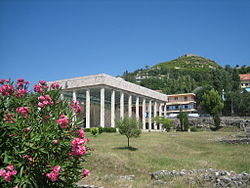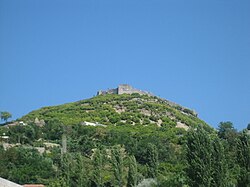Lezhë
Lezhë | |
|---|---|
|
Lezhë photomontage | |
| Coordinates: 41°47′N 19°38′E / 41.783°N 19.633°E | |
| Country | |
| County | Lezhë |
| Government | |
| • Mayor | Fran Frrokaj (PD) |
| Area | |
| • Municipality | 509.10 km2 (196.56 sq mi) |
| Elevation | 10 m (30 ft) |
| Population (2011) | |
| • Municipality | 65,633 |
| • Municipality density | 130/km2 (330/sq mi) |
| • Municipal unit | 15,510 |
| Time zone | UTC+1 (CET) |
| • Summer (DST) | UTC+2 (CEST) |
| Postal Code | 4501-4502 |
| Area Code | (0)215 |
| Website | Official Website |
Lezhë (Albanian: Lezha or Lezhë, Albanian pronunciation: [ˈlɛʒə]) is a town and municipality in northwest Albania, in the county with the same name. In ancient history it was an ancient Greek colony named Lissus. The latter is an Archaeological Park of Albania.
The present municipality was formed at the 2015 local government reform by the merger of the former municipalities Balldren, Blinisht, Dajç, Kallmet, Kolsh, Lezhë, Shëngjin, Shënkoll, Ungrej and Zejmen, that became municipal units. The seat of the municipality is the town Lezhë.[1] The total population is 65,633 (2011 census), in a total area of 509.10 square kilometres (197 square miles).[2] The population of the former municipality at the 2011 census was 15,510.[3]
Name
The town itself is known in Albanian as Lezhë. The town is known as in Turkish: Leş, Italian: Alessio, Greek: Λισσός, Lissòs, and in Macedonian: Леска, Leska.
History

The city dates back to at least 8th century BC.[4] Around 385 BC, a Greek colony was founded by Dionysius I of Syracuse by the name of Lissos (Λισσός),[5] as part of a strategy by Dionysius to secure Syracusan trade routes along the Adriatic.[6] Diodorus calls it a polis.[5] The city was separated into sectors by diateichisma[5] (Greek: διατείχισμα, "cross-wall"[7]) and there are elements of Syracusan architecture in part of its walls. At a later time it came under Illyrian rule. In 211 BC, Philip V of Macedon captured the citadel of Akrolissos, and Lissos surrendered to him.[8] The town was later recovered by the Illyrians. It was in Lissos that Perseus of Macedon negotiated an alliance against Rome with the Illyrian king Gentius, and it was from Lissos that Gentius organized his army against the Romans. Lissos maintained a large degree of municipal autonomy under both Macedonian and Illyrian rule, as evidenced by the coins minted there.[6] The city was of some importance in the Roman Civil War, being taken by Marc Antony [9] and then remaining loyal to Caesar. In Roman times, the city was part of the province of Epirus Nova,[10] its name Latinized as Lissus.[11]
From 2004 an excavation started around the ancient Acropolis of Lissos and the Skanderbeg Memorial, which revealed Hellenistic, Roman and Early Byzantine buildings, tombs and other findings.[12]

In Middle Ages Lissus (then known as Alessio) frequently changed masters until the Venetians took possession of it in 1386. It still belonged to them when Skanderbeg died, but In 1478 it fell into the hands of Turks during the siege of Shkodra, with the exception of a short period (1501–1506) when it returned to Venetian domination.[13] Because it was under the Venetian control, it was chosen in 1444 by George Castrioti (Skanderbeg) as a neutral place for the convention of Albanian, Serbian, Dalmatian and other lords of the area aiming at organizing their common defence against the Turks.[14]
According to other historians, Lezhë is considered as the site of the League of Lezhë where Skanderbeg united the Albanian princes in the fight against the Ottoman Empire.
Skanderbeg was buried in the cathedral of Lezhë which was dedicated to Saint Nicholas and later used as Selimie Mosque.
Lezhë has also been known by the Italian form of its name, Alessio and in the 19th century as Alise, Lesch, Eschenderari, or Mrtav (Catholic Encyclopedia).
Today Lezhë is a growing city. Its proximity to the port of Shëngjin as well as its location on the national road between the Montenegrin border to the North and Tirana to the South makes it an attractive location for industry and business.
Majority of the people from Lezhë descend from the Zadrima, Mirdita and Malësia/Malësi e madhe regions of northwestern Albania. The people from Zadrima and Mirdita are native to Lezhë and the surrounding area. Whilst the Malësor clans from Malësia, such as Kelmendi, Shkreli, Kastrati etc., had settled Lezhë and surrounding areas around 100–300 years ago
Sights
Transportation

Bus
There are urban buses throughout the city and international and national buses.
Trains
Lezhe has a train station not far from the center. The line starts in Durres and ends in Shkoder. It is functonally but not frequently.
Highways
The main highway in Lezhe is E762. The E762 stars in Fushë-Krujë and ends in Shkoder. The Durrës-Kukës Highway intersects with E762 in Milot, Kurbin. Also the SH32 intersects in to Lezhe coming from Shëngjin.
Sport
The association football club is KS Besëlidhja Lezhë. Although primarily concerned with football, KS Besëlidhja also participates in sports such as wrestling and beach volleyball.
Notable people
- Skanderbeg, the National Hero of Albania
- Anton Kryezezi, Bishop of Lezhë
- Lekë Dukagjini, prince
- Jonima (Gjoni) family noble family
- Gjergj Fishta, Catholic priest and poet
- Ndoc Gjetja, poet
- Henri Ndreka, soccer player, capped with Albania
- Robert Grizha, soccer player
See also
References
- ^ Law nr. 115/2014 Archived 2015-09-24 at the Wayback Machine
- ^ Interactive map administrative territorial reform
- ^ 2011 census results Archived 2015-09-24 at the Wayback Machine
- ^ Robert Elsie (2010), Historical Dictionary of Albania, Historical Dictionaries of Europe, vol. 75 (2 ed.), Scarecrow Press, p. 272, ISBN 978-0810861886,
As a settlement, Lezha, with its fortified acropolis, dates back at least to the eighth century BC.
- ^ a b c Mogens Herman Hansen, In An Inventory of Archaic and Classical Poleis, Oxford University Press, 2004, page 322, ISBN 0-19-814099-1
- ^ a b Evans, A., Destani, B., Ancient Illyria, an archeological exploration. IB Tauris, 2007. p. 276.
- ^ διατείχισμα, Henry George Liddell, Robert Scott, A Greek-English Lexicon, on Perseus Digital Library
- ^ Polybius 8.13-14
- ^ Plutarch (1920). Life of Antony. Loeb Classical Edition. p. 7.4.
- ^ Epirus Vetus: The Archaeology of a Late Antique Province (Duckworth Archaeology) by William Bowden, 2003, ISBN 0-7156-3116-0,2003, page 233, of Lissos in Epirus Nova
- ^ Diodorus Siculus, "Library", 15.13 at Perseus
- ^ Karl-Franzens Universitat, Lissus excavation report 2004. Archived 2011-06-29 at the Wayback Machine
- ^ Catholic Encyclopedia, article "Alessio (Lissus, Alexiensis)"
- ^ Schmitt Jens O.(2009) Skanderbeg, Der neue Alexander auf dem Balkan, Verlag Friedrich Pustet, pp. 55,56










